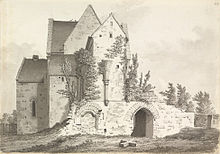Hinton Priory
 | |
| Monastery information | |
|---|---|
| Order | Carthusian |
| Established | 1227 |
| Disestablished | 1539 |
| People | |
| Founder(s) | Ela, Countess of Salisbury |
| Important associated figures | William Longspee, Earl of Salisbury |
| Site | |
| Location | Hinton Charterhouse, Somerset, England |
| Grid reference | ST778592 |
| Visible remains | buildings and earthworks |
| Public access | no |
Hinton Priory was a Carthusian monastery in northeast Somerset, England, from 1232 until 1539.
History
The priory was one of the ten medieval Carthusian houses (charterhouses) in England. It was first established at Hatherop, Gloucestershire in 1222 by William Longspee, Earl of Salisbury. The monks disliked the location, and on Longspee's death in 1226 they petitioned his countess for a new site to achieve greater solitude. She gave them her manors of Hinton and Norton St Philip in Somerset, and the new house was consecrated at a site about 0.6 miles (1 km) northeast of the village of Hinton (later called Hinton Charterhouse) in May 1232. It was called Locus Dei meaning 'God's Place'.
A "lower house" for lay brothers was established near Freshford, close to the River Frome, about 0.6 miles (1 km) to the east (grid reference ST 7884 5910). This ceased to be used, probably in the 14th century, and the lay brothers were accommodated with the main community.[1]
Hinton gained the land and property of the small Longleat Priory in 1529.[2]
The house was suppressed as part of the dissolution of the monasteries on 31 March 1539; at that time it housed the Prior, sixteen monks and six lay brothers. The property was then bought by Matthew Colthurst.[3]

Today
The chapter house, with library and dovecote above, survives and was designated as Grade I listed in 1956.[4][5] Also standing is the refectory (also Grade I)[6] which is part of a former stable yard (Grade II)[7] incorporating other early work. All now belong to the sixteenth century country house, also known as Hinton Priory, on the northern part of the site and itself a Grade I listed building.[8] Surviving earthworks from the great cloister are visible in an orchard and paddocks.
The site is a Scheduled Ancient Monument.[9][10] It is included in the Heritage at Risk Register produced by English Heritage; the entry for 2012 states that its condition is "Poor" and that some parts are in need of condition assessment.[11]
The Priory is in private ownership and there is no public access.
The site of the lower house on the River Frome is also a scheduled monument. A small current settlement there preserves the name of its predecessor in its name of "Friary". Earthworks and buried material remain, and a later cottage incorporates fragments of 14th century masonry;[1] an interpretation board was erected by the Cotswolds Conservation Board in 2017 and indicates the layout of the mediaeval buildings.
References
- ^ a b Historic England. "Site of correrie or lower house to Hinton Priory (1434671)". National Heritage List for England. Retrieved 23 August 2017.
- ^ Pugh, R.B.; Crittall, Elizabeth, eds. (1956). "Victoria County History: Wiltshire: Vol 3 pp302-303 - Houses of Augustinian canons: Priory of Longleat". British History Online. University of London. Retrieved 23 August 2017.
- ^ Greenwood, Charles (1977). Famous houses of the West Country. Bath: Kingsmead Press. pp. 40–43. ISBN 978-0-901571-87-8.
- ^ Historic England. "Chapter House of Hinton Priory (1320809)". National Heritage List for England. Retrieved 23 August 2017.
- ^ Historic England. "The chapel, Hinton Charterhouse (1320809)". National Heritage List for England. Retrieved 23 August 2017.
- ^ Historic England. "Refectory, to west of Chapter House (1129461)". National Heritage List for England. Retrieved 23 August 2017.
- ^ Historic England. "Stables, Coach-house and Wall enclosing stable yard (1320806)". National Heritage List for England. Retrieved 23 August 2017.
- ^ Historic England. "Hinton Priory (1136191)". National Heritage List for England. Retrieved 23 August 2017.
- ^ "List of Scheduled Ancient Monuments". Bath and North East Somerset Council. Archived from the original on 18 September 2010. Retrieved 9 October 2010.
- ^ Historic England. "Hinton Priory (monument) (1007014)". National Heritage List for England. Retrieved 23 August 2017.
- ^ "Heritage At Risk Register 2012: South West England" (PDF). English Heritage. September 2012. p. 19. Archived from the original (PDF) on 1 November 2013.
- Glyn Coppack and Mick Aston: Christ's Poor Men — the Carthusians in England ISBN 0-7524-1961-7
- Use dmy dates from October 2011
- Archaeological sites in Somerset
- Carthusian monasteries in England
- Christian monasteries established in the 13th century
- Monasteries dissolved under the English Reformation
- Grade I listed buildings in Bath and North East Somerset
- Grade I listed monasteries
- Monasteries in Somerset
- Ruined abbeys and monasteries
- Ruins in Somerset
- Scheduled Ancient Monuments in Bath and North East Somerset
- Structures on the Heritage at Risk register in Somerset
- 1222 establishments in England
- 1539 disestablishments in England
